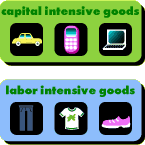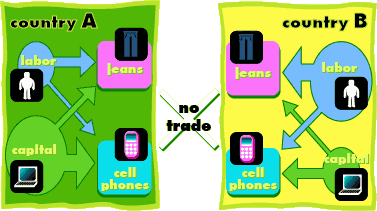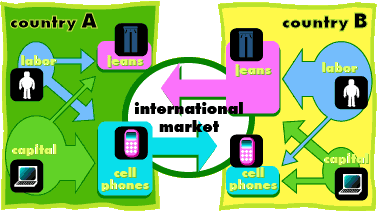Please read the important information regarding these games at the bottom of the page.
Why trade?
Introduction
 The Heckscher-Ohlin theory explains why countries trade goods and services with each other. One condition for trade between two countries is that the countries differ with respect to the availability of the factors of production. They differ if one country, for example, has many machines (capital) but few workers, while another country has a lot of workers but few machines. According to the Heckscher-Ohlin theory, a country specializes in the production of goods that it is particularly suited to produce. Countries in which capital is abundant and workers are few, therefore, specialize in production of goods that, in particular, require capital. Specialization in production and trade between countries generates, according to this theory, a higher standard-of-living for the countries involved.
The Heckscher-Ohlin theory explains why countries trade goods and services with each other. One condition for trade between two countries is that the countries differ with respect to the availability of the factors of production. They differ if one country, for example, has many machines (capital) but few workers, while another country has a lot of workers but few machines. According to the Heckscher-Ohlin theory, a country specializes in the production of goods that it is particularly suited to produce. Countries in which capital is abundant and workers are few, therefore, specialize in production of goods that, in particular, require capital. Specialization in production and trade between countries generates, according to this theory, a higher standard-of-living for the countries involved.
From cakes to a gold medal
Bertil Ohlin was born in 1899. At the age of five, Bertil was very fond of calculating the cost of the various cakes his mother baked. Because mathematics was his favorite subject in school, he decided to study mathematics, statistics, and economics in college. After graduating from college, Bertil Ohlin enrolled at the Stockholm School of Economics, where he studied under the guidance of the economics historian Eli Heckscher. Together they developed the pathbreaking Heckscher-Ohlin theory in the 1920s. Many years later, in 1977,Bertil Ohlin was awarded The Sveriges Riksbank Prize in Economic Sciences in Memory of Alfred Nobel for his contribution to the theory of international trade, based on the work he did with Heckscher. Eli Heckscher, who died in 1952, did not share the prize since it is not awarded posthumously. Instead Ohlin shared the prize with the British economist James E. Meade.
 |
Between 1944 and 1967, Bertil Ohlin was the leader of the Swedish Liberal Party, and between 1944 and 1945 he was also the Secretary of Trade of the Swedish Government. Bertil Ohlin died in 1979. |
What is an economic theory?
One can compare an economic theory with a map over of a piece of land. A map gives an idea of what a certain piece of land looks like, even though nature is too complex to be described completely by it. While a map can help us understand an unknown terrain, economic theories help us understand economic interactions between individuals or countries. For example, why individuals or countries trade with each other and why trade may benefit the parties involved.
Machines and workers
 The production of goods and services requires capital and workers. Some goods require more capital - technical equipment and machinery - and are called capital intensive. Examples of these goods are cars, computers, and cell phones.
The production of goods and services requires capital and workers. Some goods require more capital - technical equipment and machinery - and are called capital intensive. Examples of these goods are cars, computers, and cell phones.
Other goods require less equipment to produce and rely mostly on the efforts of the workers. These goods are called labor intensive. Examples of these goods are shoes and textile products such as jeans.
Gains from trade
By specializing in production, and by trading with other countries, it is possible for countries to increase their incomes. Even though countries as a whole benefit from specialization and international trade, all groups in society, workers and capitalists, do not gain according to the Heckscher-Ohlin theory. If international trade leads a country to specialize in producing goods that require lots of workers and little capital, such a specialization increases wages (which benefits the workers) but decreases the income of the capital owners. But the country as a whole benefits because the gain of the workers is bigger than the loss of the capital owners.
The Heckscher-Ohlin trade theory
The Heckscher-Ohlin theory says that two countries trade goods with each other (and thereby achieve greater economic welfare), if the following assumptions hold:
- The major factors of production, namely labor and capital, are not available in the same proportion in both countries.
- The two goods produced either require relatively more capital or relatively more labor.
- Labor and capital do not move between the two countries.
- There are no costs associated with transporting the goods between countries.
- The citizens of the two trading countries have the same needs.
Bigger differences - greater gains
Of the above conditions, the central one is the assumption that capital and labor are not available in the same proportion in the two countries. This condition leads to specialization. The country with relatively more capital specializes - but not necessarily fully - in production of capital-intensive goods (which it exports in exchange for labor-intensive goods) while the country with relatively little capital specializes in production of labor-intensive goods (which it exports in exchange for capital-intensive goods).
According to the theory, the more different the countries are - regarding the capital-to-labor ratio - the greater the economic gain from specialization and trade.
 |
In 2005 Germany and the United States were the two biggest exporting countries in the world, followed by China and Japan. |
Example:
Imagine two countries that each produces both jeans and cell phones. Although both countries use the same production technologies, one has a lot of capital but a limited number of workers, while the other country has little capital but lots of workers.
The country that has a lot of capital but few workers can produce many cell phones but few pairs of jeans because cell phones are capital intensive and jeans are labor intensive. The country with many workers but little capital, on the other hand, can produce many pairs of jeans but few cell phones.
According to the Heckscher-Ohlin theory, trade makes it possible for each country to specialize. Each country exports the product the country is most suited to produce in exchange for products it is less suited to produce. The country that has a lot of capital specializes in the production of cell phones, whereas the country that has more labor specializes in the production of jeans.
 |
In this case, neither country has specialized in producing more of one of the two particular products - both countries produce about the same number of jeans and cell phones. |
 |
Country A - having more capital than labor - has specialized in producing more cell phones. Country B - having more labor than capital - has specialized in producing more jeans. In this case, trade may benefit both countries involved. |
Other prize laureates' work on trade theory
Several other economists continued the work of Heckscher and Ohlin - notably, Paul A. Samuelson, who received the Prize in Economics 1970. Bertil Ohlin had informally argued that international trade would tend to equalize factor prices across countries. In other words, trade between India (with a lot of labor) and the United States (with a lot of capital), for example, would narrow the wage differences between the two countries. Samuelson was able to show mathematically that initial wage differences between countries disappear because of trade in the Heckscher-Ohlin model (if the assumptions of the model are fulfilled). This result is called the Factor Price Equalization Theorem.
Wassily Leontief received the Prize in Economics in 1974. In one of his papers on trade theory he shows why the United State's (U.S.) exports do not reflect a factor of production very abundant in the U.S. - capital. Even though the U.S. has more capital than most nations, most of its exports were of goods requiring a lot of labor and its imports were mostly goods requiring capital. This is the opposite of the outcome that one would at first expect from the Heckscher-Ohlin theory! However, Leontief's explanation was that the workers in the U.S. have a lot of knowledge. In other words, the U.S. exports the goods that require a production factor that the U.S. is particularly well-endowed with, namely knowledge. Thus, Leontief's explanation was consistent with the Heckscher-Ohlin theory.
RELATED LAUREATE |
TIPS |
| Bertil Ohlin - Laureate in Economics, 1977 | Play the Trade Ruler Game! |
First published 28 February 2006
MLA style: "Why Trade?". Nobelprize.org. Nobel Prize Outreach AB 2022. <http://nobel-external-educationalgames-app.azurewebsites.net/educational/economic-sciences/trade/ohlin.php>
About the educational games
The educational games are based on Nobel Prize awarded achievements and were produced between 2001 and 2012. Most games have not been updated since production (including potential scientific facts changes) and are provided here on an 'as is' basis by popular demand.
Some of the games run in modern browsers without the need of any plugin (either as a new version or using Ruffle), but many of the games still require Adobe Flash Player. Flash is an old technology that has reached end of life. These games will no longer work without a dedicated setup. If you are depending on these games in your profession, please advice your local IT support. We do not have the resources to provide support.
We are working on supporting more games without Flash.